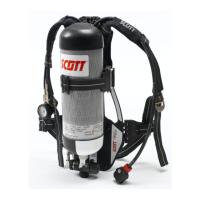PRO-PAK
6
2.5 REDUCER
The reducer is a simple, self-regulating,
spring and piston device that requires no
adjustment. It has a pressure relief valve
(PRV) that protects the MP system from
over-pressurisation.
Air from the reducer is connected through
a reinforced, chlorinated polyethylene
hose to the facemask-mounted DV, which
regulates the air supplied to the wearer.
2.6 GAUGE AND WHISTLE
A high-pressure hose from the reducer
inlet manifold connects air, at cylinder
pressure, to a warning whistle and
pressure gauge.
On standard versions, the warning whistle
and pressure gauge are mounted on the
left-hand shoulder strap. On versions
fitted with the IRIS data-communications
system, the warning whistle and pressure
gauge are incorporated within the IRIS
unit.
The warning whistle sounds when
pressure in the cylinder falls to 55 bar (±5
bar).
The duration of the air remaining in the
cylinder, from the start of the warning
whistle, is listed for each cylinder type
under Warning Period in Table 3.
The pressure gauge dial is photo
luminescent to aid use in low light levels.
The lens is impact resistant
polycarbonate. A rubber shroud protects
the gauge.
Should the gauge, whistle or hose
become damaged, a restrictor in the
reducer limits air-loss to less than 25
litres per minute.
2.7 DEMAND VALVE
The DV operates in conjunction with the
facemask spring loaded exhale valve to
maintain a positive pressure within the
facemask.
The DV has a servo-assisted tilting
diaphragm mechanism that responds to
pressure changes within the facemask to
regulate the flow of air to the mask,
ensuring that pressure within the mask
remains safely above ambient.
The DV has a reset button that enables
wearers to close the airflow through the
DV, permitting the facemask to be
removed during test procedures and at
the end of a task, without loss of cylinder
air.
When the apparatus is donned the DV is
normally ‘reset’ (closed), and is opened
(activated) when the wearer takes a first
breath.
The DV has a supplementary flow device
(bypass), that the wearer can open using
the bypass knob.
When the bypass is used, the
unregulated flow of air through the DV
reduces cylinder duration.
The DV is connected to the facemask by
a Quick-Fit (QF) bayonet fitting with a
spring-loaded locking catch to prevent
accidental disconnection.

